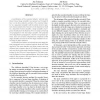Free Online Productivity Tools
i2Speak
i2Symbol
i2OCR
iTex2Img
iWeb2Print
iWeb2Shot
i2Type
iPdf2Split
iPdf2Merge
i2Bopomofo
i2Arabic
i2Style
i2Image
i2PDF
iLatex2Rtf
Sci2ools
96
Voted
ICPR
2004
IEEE
2004
IEEE
Inter-Stage Feature Propagation in Cascade Building with AdaBoost
A modification of the cascaded detector with the AdaBoost trained stage classifiers is proposed and brought to bear on the face detection problem. The cascaded detector is a sequential classifier with the ability of early rejection of easy samples. Each decision in the sequence is made by a separately trained classifier, a stage classifier. In proposed modification the features from one stage of training are propagated to the next stage classifier. The proposed intra-stage feature propagation is shown to be greedily optimal, does not increase computational complexity of the stage classifier and leads to shorter stage classifiers and accordingly to faster detectors. A cascaded face detector is built with the intra-stage feature propagation and is compared with the Viola and Jones approach. The same detection and false positive rates are achieved with a detector that is 25 % faster and consists of only two thirds of the weak classifiers needed for a cascade trained by the Viola and Jone...
| Added | 09 Nov 2009 |
| Updated | 09 Nov 2009 |
| Type | Conference |
| Year | 2004 |
| Where | ICPR |
| Authors | Jan Sochman, Jiri Matas |
Comments (0)

